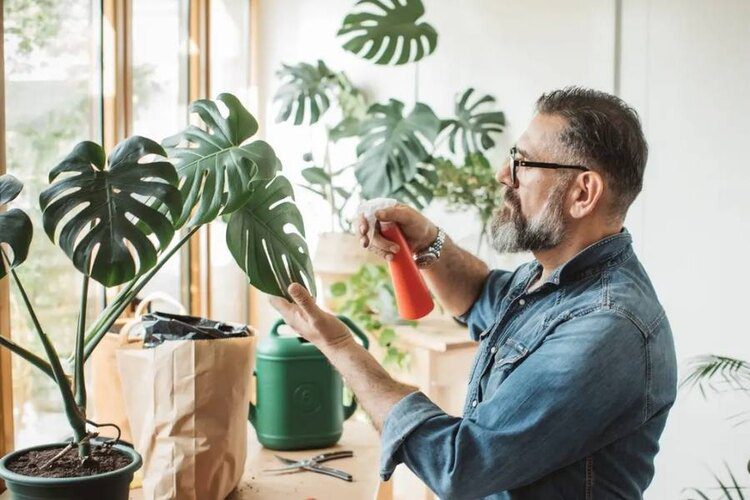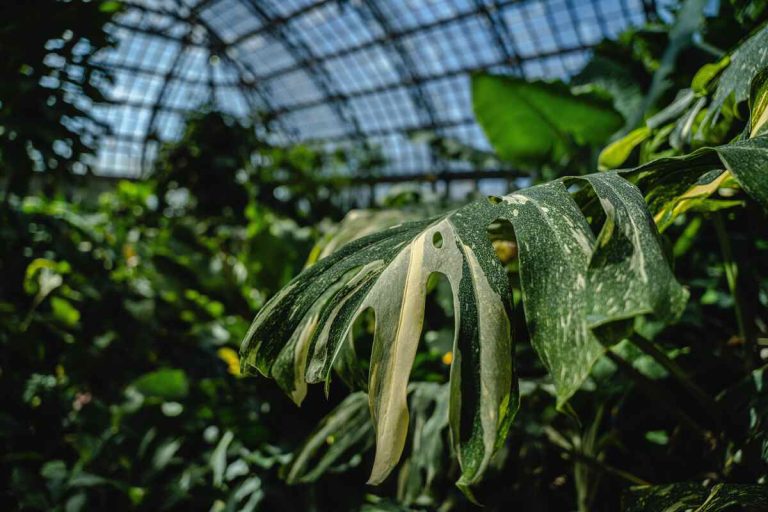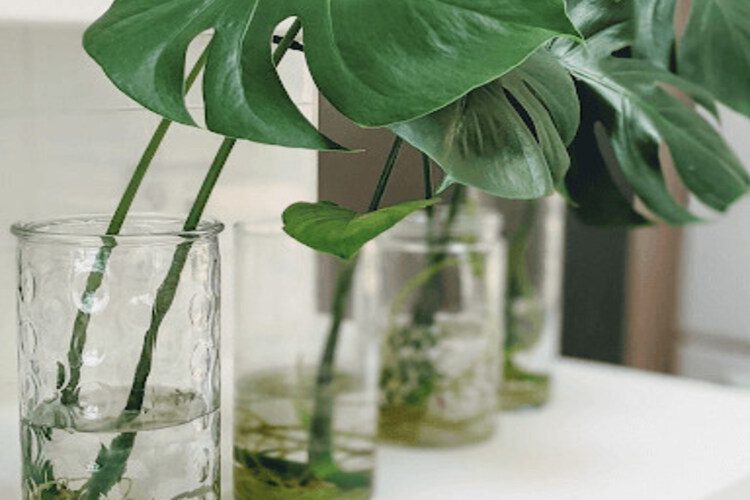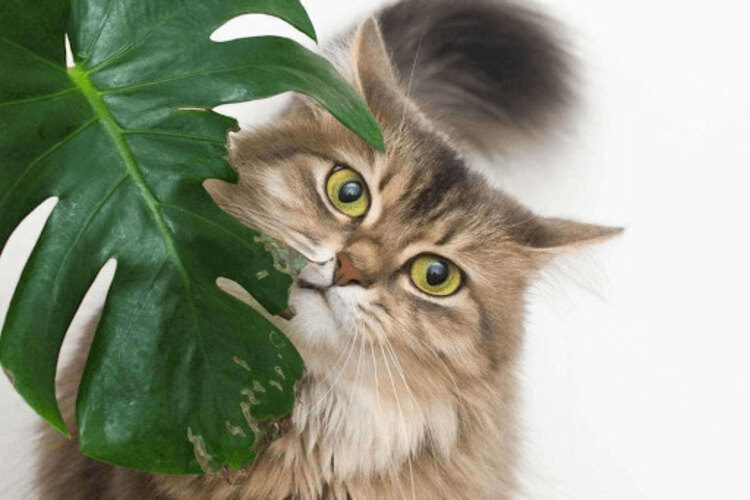Why Is My Monstera Sweating? 3 Main Causes & How To Help

You may see drops of water on the tops of your cheese plant’s leaves, especially in the morning. Why is Monstera sweating? The sweating process is normal for this plant. It needs to expel excess water so that it doesn’t become overwhelmed.
We will give you an in-depth discussion about this symptom. Let’s read through and take action when necessary!
Why Is My Monstera Sweating?
The main reasons for the Monstera plant’s sweating are guttation, transpiration, or dew. It’s most likely due to transpiration, mainly if it grows outside, although it might also be guttation in some situations.
Guttation
The natural process by which plants discharge extra moisture from their cells is guttation. The root of this plant sometimes absorbs more water than it can transpire because the soil is too wet. The root must then dispose of the surplus water.
The pressure in the root system will cause xylem tissues to begin transferring water up the stem and through the plant’s leaves. Because the xylem tissues supply the Monstera with sap, they have adapted to transport liquids. Excessive water pressure will push its way through the leaves’ holes, causing them to sweat.

Transpiration
Transpiration aids monstera plants in removing the excess water in the form of vapour during the day and night. However, since this natural process does not occur at night, the water levels increase. An internal pressure forms when monstera plants take in mineral salt and excess water through their root systems. During the day, these tropical plants keep on absorbing these substances.
As a result, your monstera plant has to extract the excess water. The xylem sap, driven by root pressure, releases surplus water and salts through hydathodes, which are abundant on the leaf tips.
Dew
Your Monstera may have droplets of water on its leaves if it is in a highly humid area, especially during the night. Evaporation occurs at night, and the water condenses on the plant’s leaves, generating dew drops that you may see the following day. Dew is different from the water that a plant loses through transpiration or guttation. You don’t need to worry because these droplets do not affect your plant.
Dew Vs. Guttation In Monstera
In the morning, you’ll notice tiny drops of water on your Monstera leaves. Sometimes you don’t know if the droplets are dew or guttation. The formation of dew is not a plant-based process. It happens in the air, causing small water droplets known as dew to collect on the leaf surfaces. The soil emits the heat accumulated throughout the day through evaporation at night. When the water vapour comes into contact with a cold surface, such as a leaf, it compresses to form small water droplets. You can easily find these drops on the grass or plant leaves in the morning. Due to their similar appearance, many people confuse dew with guttation.
Dew creation often results from favourable circumstances such as a light breeze, a clear sky, wet soil, high moisture levels, and mild nighttime dew depressions. Variations in these settings explain why some days you can notice tiny droplets of water on the plant leaves while you can hardly see them on other days. Dew will not accumulate on the leaf surfaces of indoor plants unless the moisture level in your home is very high. If you notice water droplets on plants inside your home, it’s likely due to the guttation or a high level of humidity.
This comparison table can help you distinguish the two processes more easily:
| Criteria | Guttation | Dew |
| Definition | The physiological process of eliminating xylem sap from leaf tips via hydathodes | The meteorological process of water evaporation |
| Appearance | Water droplets | Water droplets |
| Deposition | On the leaf tips | On the entire leaf |

Is Sweating Bad For Monstera Plants?
Some people worry when they see a Monstera dripping water, but it isn’t always a reason to panic. Dripping water can cause some sap to be lost, but this is not a big deal if it just happens once in a while. In fact, sweating on Monstera helps prevent yellow leaves by helping to regulate the plant’s water balance. You don’t want to be anxious about Monstera plants, but you also don’t want them to get ill due to your ignorance. So when should we worry? Is gutting bad? Guttation that occurs on the same day that you water your plant is not a cause for concern. You don’t have to worry about overnight gutting. However, if it happens again the next day, check your plant.
At this point, the soil must not be too damp. Otherwise, it will cause root pressure. In this case, check the ventilation or lower the amount of water you give the plant. You may also want to use less water in the pot since this method will help limit the amount of water absorbed by the roots with each irrigation. Do not ignore it if guttation happens repeatedly. It’s an indication that something wrong is happening. A Swiss cheese plant with damp roots for an extended length of time is at risk of root rot, which can be dangerous if not treated.
What Should You Do About Dripping Monstera?
Nobody likes soap and water all over their floors every morning. If Monstera deliciosa drips water excessively, you may wonder how to prevent it. Luckily, there are several tips available to you.
Adjust watering schedule
The first thing to do is cut down on how much water you feed your plant. If it doesn’t get much water, it won’t be able to soak it up. Limiting the frequency with which you irrigate will have a similar effect. Try to balance it carefully and adequately. If you don’t feed monstera plants too much water when Monsteras are overwatered, they won’t be able to absorb more than they can take. Then, they won’t need to get rid of the excess moisture by guttation.
Reduce moisture level
During the day, these vascular plants release excess water by letting it evaporate via their pores. They can’t do it if the humidity is too high because water doesn’t evaporate effectively in this situation. This is a problem of Monstera plants because they prefer a high humidity level. Although monstera plants prefer a high humidity level, lowering it might help them shed more moisture through their leaves when necessary. Consider placing a hygrometer near the plant so that you can monitor humidity levels and adjust them as required.
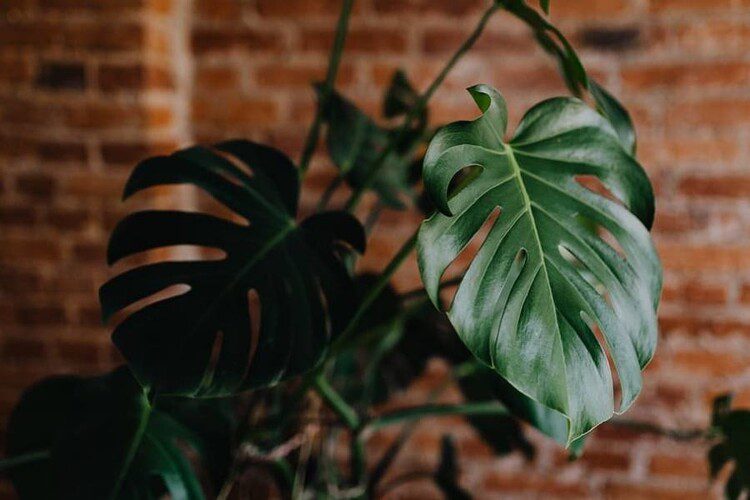
Contain the mess
Place a tray or cloth beneath the plant to contain the water droplets. This tip helps you keep the mess to a minimum by collecting the raindrops as they fall. Containing the mess may be a good option if you find yourself cleaning up after your Monstera so often. If at all feasible, place the indoor plants on a firm floor to make cleanup quicker. If you store your Monstera on a carpet, place something underneath it to avoid guttation.
Increase light
Guttation occurs mainly at night when the plant’s stomata seal its pores. More water will evaporate quickly into the air instead of pushing its way through blocked pores if you help the Monstera keep its pores open longer. Increase the amount of light exposed to your Monstera. Then, it will keep the pores open, allowing the moisture in the plant’s leaves to escape more efficiently. You may either buy a grow light or relocate your Monstera to a new position with more light.
Enhance soil drainage
If the soil around the plant can’t drain adequately, it will remain damp for days. It may drain poorly, and some areas may remain damper than others. As a result, you can’t tell when the Monstera needs watering and when it doesn’t. This issue makes the soil damper, and you don’t realise it because the top is still dry. It would be best to take your plant out of its pot and check what’s happening if you’re having difficulties with germination. It would be best to take your plant out of its pot and check what’s happening if your Monstera plants are drooping.
Conclusion
If your Monstera is sweating, make sure you are not overwatering it. A need to release extra water once in a while is fine, but continuous guttation matters. Make sure you water the plant correctly and that it has enough drainage. Hopefully, you will find this article helpful. If you have any questions about gardening tips, please feel free to ask. We will get back to you soon.


